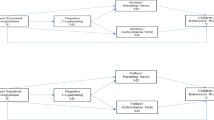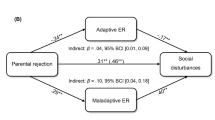Abstract
Rationale
Early parental loss has been associated with neuroendocrine dysregulation in youth; however, the form of cortisol dysregulation varies widely. Identifying risk and protective factors that influence physiological regulation has important implications for understanding the development of mental health problems in parentally bereaved youth.
Objectives
The current study investigated the prospective effects of positive parenting on the relation between recent negative life events and cortisol activity in adolescents/young adults several years after bereavement.
Methods
Positive parenting was assessed an average of 18.5 months following parental death. Six years later, adolescents/young adults (N = 55) reported on exposure to recent negative life events, and salivary cortisol was assessed before and after a conflict discussion task with their caregiver. The interaction between positive parenting and exposure to recent negative events was used to predict total cortisol output and response to the task.
Results
Multilevel modeling and the probing of the interaction effect demonstrated that total cortisol output increased with greater exposure to recent negative events among those with lower levels of past positive parenting. These relations were significant over and above current internalizing and externalizing symptoms.
Conclusions
The current results highlight the need to consider the interactive influence of proximal and distal factors on neuroendocrine functioning for youth exposed to early parental loss.

Similar content being viewed by others
Notes
Use of psychotropic medication has also been shown to influence HPA axis functioning. Only two subjects reported current use of psychiatric medications. Analyses were run with and without these two subjects and results were the same.
References
Achenbach T, Rescorla L (2001) Manual for the ASEBA school-age forms and profiles. University of Vermont, Research Center Children, Youth, and Families University of Vermont, Research Center Children, Youth, and Families
Adam EK, Klimes-Dougan B, Gunnar MR (2007) Social regulation of the adrenocortical response to stress in infants, children, and adolescents: implications for psychopathology and education. In: Coch D, Dawson G, Fischer KW (eds) Human behavior, learning, and the developing brain: atypical development. Guilford, New York, pp 264–304
Aiken LS, West SG (1991) Multiple regression: testing and interpreting interactions. Sage, Thousand Oaks
Ayers TS, Sandler IN, Twohey JL (1998) Conceptualization and measurement of coping in children and adolescents. Adv Clin Child Psych 20:243–301
Bevans K, Cerbone A, Overstreet S (2008) Relations between recurrent trauma exposure and recent life stress and salivary cortisol among children. Dev Psychopathol 20:252–272
Bloch M, Peleg I, Koren D, Aner H, Klein E (2007) Long-term effects of early parental loss due to divorce on the HPA axis. Horm Behav 51:516–523
Burke HM, Davis MC, Otte C, Mohr DC (2005) Depression and cortisol responses to psychological stress: a meta-analysis. Psychoneuroendocrinology 30:846–856
Cerel J, Fristad MA, Verducci J, Weller EB, Weller RA (2006) Childhood bereavement: psychopathology in the 2 years postparental death. J Am Acad Child Psy 45:681–690
Cohen J (1960) A coefficient of agreement for nominal scales. Educ Psychol Meas 20:37–46
Cohen J (1988) Statistical power analysis for the behavioral sciences, 2nd edn. Lawrence Earlbaum Associates, Hillsdale
Davies PT, Sturge-Apple ML, Cicchetti D, Cummings EM (2007) The role of child adrenocortical functioning in pathways between interparental conflict and child maladjustment. Dev Psychol 43:918–930
Dowdney L (2000) Childhood bereavement following parental death. J Child Psychol Psyc 14:819–830
Doyle KW, Wolchik SA, Dawson-McClure SR, Sandler IN (2003) Positive events as a stress buffer for children and adolescents in families in transition. J Clin Child Adolesc Psycho 32:536–545
Felner RD, Terre L, Rowlison RT (1988) A life transition framework for understanding marital dissolution and family reorganization. In: Wolchik SA, Karoly P (eds) Children of divorce: empirical perspectives on adjustment. Gardner, New York, pp 35–65
Flinn MV, Quinlan RJ, Decker SA, Turner MT, England BG (1996) Male–female differences in effects of parental absence on glucocorticoid stress response. Hum Nature-Int Bios 7:125–162
Gunnar MR (2007) Stress effects on the developing brain. In: Romer D, Walker EF (eds) Adolescent psychopathology and the developing brain: integrating brain and prevention science. Oxford University Press, New York, pp 127–147
Hagan MJ, Luecken LJ, Sandler IN, Tein J-Y (2010) Prospective effects of post-bereavement negative events on cortisol activity in parentally bereaved youth. Dev Psychobiol
Haine RA, Wolchik SA, Sandler IN, Millsap RE, Ayers TS (2006) Positive parenting as a protective resource for parentally bereaved children. Death Stud 30:1–28
Hazzard A, Christensen A, Margolin G (1983) Children’s perceptions of parental behaviors. J Abnorn Child Psych 11:49–59
Heim C, Newport DJ, Wagner D, Wilcox MM, Miller AH, Nemeroff CB (2002) The role of early adverse experience and adulthood stress in the prediction of neuroendocrine stress reactivity in women: a multiple regression analysis. Depress Anxiety 15:117–125
Jensen EW, James SA, Boyce WT, Hartnett SA (1983) The family routines inventory: development and validation. Soc Sci Med 17:201–211
Jones S, Twohey JL (1998) Parents’ Expression of Emotions Questionnaire: Psychometric properties. San Francisco, CA: Poster presented at the Annual Convention of the American Psychological Association
Kraemer HC, Stice E, Kazdin A, Offord D, Kupfer D (2001) How do risk factors work together? Mediators, moderators, and independent, overlapping, and proxy risk factors. Am J Psychiatry 158:848–856
Luecken LJ (2000) Parental caring and loss during childhood and adult cortisol responses to stress. Psychol Health 15:841–851
Luecken LJ, Lemery KS (2004) Early caregiving and physiological stress responses. Clin Psychol Rev 24:171–191
Luecken LJ, Appelhans BM (2006) Early parental loss and salivary cortisol in young adulthood: the moderating role of family environment. Dev Psychopathol 18:295–308
Luecken LJ, Kraft A, Appelhans BM, Enders C (2009) Emotional and cardiovascular sensitization to daily stress following childhood parental loss. Dev Psychol 45:296–302
Lutzke JR, Ayers TS, Sandler IN, Barr A (1997) Risks and interventions for the parentally bereaved child. In: Wolchik SA, Sandler IN (eds) Handbook of children’s coping: linking theory and intervention. Issues in clinical child psychology. Plenum, New York, pp 215–243
McEwen BS (1998) Stress, adaptation, and disease: allostasis and allostatic load. In: McCann SM, Lipton JM, Sternberg EM, Chrousos GP, Gold PW, Smith CC (eds) Neuroimmunomodulation: molecular aspects, integrative systems, and clinical advances (Annals of the New York Academy of Sciences). Academy of Sciences, New York, pp 33–44
McEwen BS, Wingfield JC (2003) The concept of allostasis in biology and biomedicine. Horm Behav 43:2–15
Meinlschmidt G, Heim C (2005) Decreased cortisol awakening response after early loss experience. Psychoneuroendocrinology 30:568–576
Murphy BE (1997) Antiglucocorticoid therapies in major depression: a review. Psychoneuroendocrinology 22(Suppl 1):S125–S132
Nicolson NA (2004) Childhood parental loss and cortisol levels in adult men. Psychoneuroendocrinology 29:1012–1018
Nicolson NA (2008) Measurement of cortisol. In: Luecken LJ, Gallo LC (eds) Handbook of physiological research methods in health psychology. Sage, Thousand Oaks, pp 37–74
Kwok O-M, Haine RA, Sandler IN, Ayers TS, Wolchik SA, Tein J-Y (2005) Positive parenting as a mediator of the relations between parental psychological distress and mental health problems of parentally bereaved children. J Clin Child Adolesc Psycho 34:260–271
Pendry P, Adam EK (2007) Associations between parents’ marital functioning, maternal parenting quality, maternal emotion and child cortisol levels. Int J Behav Dev 31:218–231
Pfeffer CR, Altemus M, Heo M, Jiang H (2007) Salivary cortisol and psychopathology in children bereaved by the september 11, 2001 terror attacks. Biol Psychiatry 61:957–965
Power TG (2004) Stress and coping in childhood: the parents’ role. Parent Sci Pract 4:271–317
Prinz RJ, Foster SL, Kent RN, O’Leary KD (1979) Multivariate assessment of conflict in distressed and nondistressed mother-adolescent dyads. J Appl Behav Anal 12:691–700
Pruessner JC, Kirschbaum C, Meinlschmid G, Hellhammer DH (2003) Two formulas for computation of the area under the curve represent measures of total hormone concentration versus time-dependent change. Psychoneuroendocrinology 28:916–931
Raison CL, Miller AH (2003) When not enough is too much: the role of insufficient glucocorticoid signaling in the pathophysiology of stress-related disorders. Am J Psychiat 160:1554–1565
Raudenbush SW, Byrk AS (2002) Hierarchical linear models: applications and data analysis methods. Sage, Thousand Oaks
Sandler IN, Guenther R (1985) Assessment of life stress. In: Karoly P (ed) Measurement strategies in health psychology. Wiley, New York, pp 555–600
Sandler IN, Ramirez R, Reynolds K (1986) Life stress for children of divorce, bereaved, and asthmatic children. Paper presented at the Annual Convention of the American Psychological Association
Sandler IN, Wolchik SA, Braver S, Fogas B (1991) Stability and quality of life events and psychological symptomatology in children of divorce. Am J Commun Psychol 19:501–520
Sandler IN, West SG, Baca L, Pillow DR et al (1992) Linking empirically based theory and evaluation: the Family Bereavement Program. Am J Commun Psychol 20:491–521
Sandler IN, Ayers TS, Wolchik SA, Tein J-Y, Kwok O-M, Haine RA, Twohey-Jacobs J, Suter J, Lin K, Padgett-Jones S, Weyer JL, Cole E, Kriege G, Griffin WA (2003) The Family Bereavement Program: efficacy evaluation of a theory-based prevention program for parentally bereaved children and adolescents. J Consult Clin Psych 71:587–600
Sarason IG, Johnson JH, Siegel JM (1978) Assessing the impact of life changes: development of the life experiences survey. J Consult Clin Psych 46:932–946
Schaefer ES (1965) Children’s reports of parental behavior: an inventory. Child Dev 36:413–424
Tremblay GC, Israel AC (1998) Children’s adjustment to parental death. Clin Psychol-Sci Pr 5:424–438
Wolchik SA, Wilcox KL, Tien J, Sandler IN (2000) Maternal acceptance and consistency of discipline as buffers of divorce stressors on children’s psychological adjustment problems. J Abnorm Child Psych 28:87–102
Wolchik SA, Sandler IN, Winslow E, Smith-Daniels V (2005) Programs for promoting parenting of residential parents: moving from efficacy to effectiveness. Fam Court Rev 43:65–80
Wolchik SA, Tien J, Sandler IN, Ayers TS (2006) Stressors, quality of child-caregiver relationship, and children's mental health problems after parental death: The mediating role of self-system beliefs. J Abnorm Child Psych 34:221–238
Zobel AW, Nickel T, Sonntag A, Uhr M, Holsboer F, Ising M (2001) Cortisol response in the combined dexamethasone/CRH test as predictor of relapse in patients with remitted depression: a prospective study. J Psychiat Res 35:83–94
Author information
Authors and Affiliations
Corresponding author
Rights and permissions
About this article
Cite this article
Hagan, M.J., Roubinov, D.S., Gress-Smith, J. et al. Positive parenting during childhood moderates the impact of recent negative events on cortisol activity in parentally bereaved youth. Psychopharmacology 214, 231–238 (2011). https://doi.org/10.1007/s00213-010-1889-5
Received:
Accepted:
Published:
Issue Date:
DOI: https://doi.org/10.1007/s00213-010-1889-5




